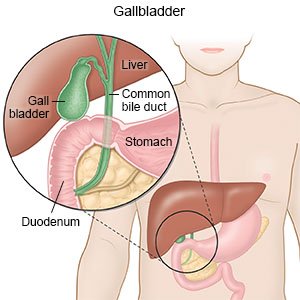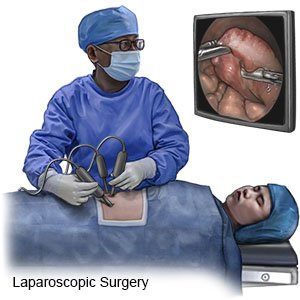Laparoscopic Cholecystectomy in Children
Medically reviewed by Drugs.com. Last updated on Aug 4, 2025.
What do I need to know about laparoscopic cholecystectomy?
Laparoscopic cholecystectomy is surgery to remove gallstones and your child's gallbladder.
 |
How do I help my child prepare for surgery?
- Your child's surgeon will tell you how to prepare. Tell him or her about all the medicines your child currently takes. The surgeon will tell you if your child needs to stop any medicine for surgery, and when to stop. He or she will tell you which medicines to give or not give your child on the day of surgery. You may be told not to let your child eat or drink anything after midnight on the day of surgery.
- Tell your child's surgeon about any allergies he or she has, including medicines and anesthesia. Your child may need blood or urine tests. He or she may also need x-rays, an ultrasound, or a CT scan. Tell your child's surgeon if he or she had an allergic reaction to contrast liquid.
Related medications
What will happen during surgery?
- The surgeon will make 1 to 4 small incisions in your child's abdomen or belly button. He or she will insert small tools into the incisions. Your child's abdomen will be filled with carbon dioxide gas to make it swell. This helps the surgeon see the organs better and gives him or her room to move the tools around.

- Your child's surgeon will look for and remove gallstones in and around the gallbladder. He or she will carefully remove your child's gallbladder through one of the incisions. The carbon dioxide will be released from his or her abdomen. The incisions will be closed with stitches, medical glue, or adhesive strips, then covered with bandages.
What should my child expect after surgery?
Your child will be taken to a recovery room until he or she is fully awake. Healthcare providers will monitor your child closely for any problems. Providers will help him or her walk around to prevent blood clots. Your child may be able to go home later the same day or may stay in the hospital overnight.
- Pain, a sore throat, nausea, and vomiting are common after this surgery. These should get better within a few days. Your child may also have diarrhea that lasts up to a few months.
- Medicines may be given to prevent or treat pain, nausea, and vomiting. Medicines may also be given to prevent a bacterial infection. Blood thinners may be given to prevent blood clots. Your child may bleed or bruise more easily while he or she is taking blood thinners.
- Your child's surgeon will tell you when to remove the bandages covering the surgery area. He or she will tell you when it is okay for your child to start bathing. Your child may need to take showers instead of baths for a few days.
- Your child's surgeon will tell you when your child can return to school and regular daily activities. If your child is a teen, the surgeon will say when it is okay to drive or work.
- You will be shown how to care for the surgery area and check for signs of infection. You will also be told which foods to give your child in the days and weeks after surgery.
What are the risks of a laparoscopic cholecystectomy?
- Your child could bleed more than expected or get an infection. Nausea and vomiting are common after this surgery. Any carbon dioxide gas that remains in your child's body can cause neck and shoulder pain. Your child's gallbladder may leak bile into his or her abdomen during or after surgery. This can cause a severe infection or an abscess.
- Your child's surgeon may need to make a larger incision than expected during surgery. Your child may still have gallstones after surgery. He or she may need a different procedure to remove them. Your child's bile duct, bowel, or other organs could be damaged during surgery. This can be life-threatening.
Care Agreement
You have the right to help plan your child's care. Learn about your child's health condition and how it may be treated. Discuss treatment options with your child's healthcare providers to decide what care you want for your child. The above information is an educational aid only. It is not intended as medical advice for individual conditions or treatments. Talk to your doctor, nurse or pharmacist before following any medical regimen to see if it is safe and effective for you.© Copyright Merative 2025 Information is for End User's use only and may not be sold, redistributed or otherwise used for commercial purposes.
Further information
Always consult your healthcare provider to ensure the information displayed on this page applies to your personal circumstances.
